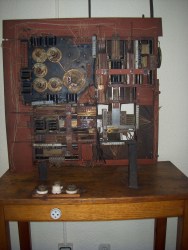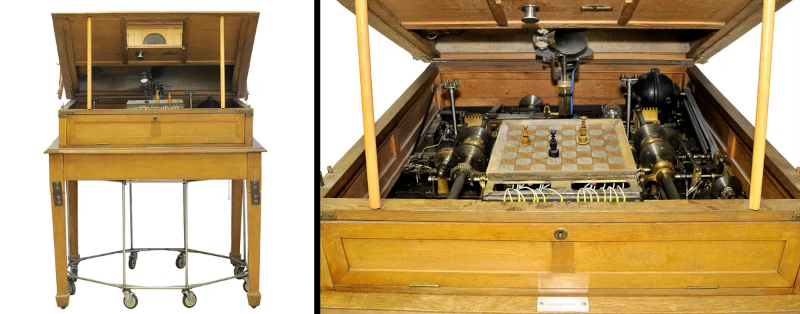Who was [Leonardo Torres Quevedo]? Not exactly a household name, but as [IEEE Spectrum] points out, he invented a chess automaton in 1920 that would foreshadow the next century’s obsession with computers playing chess.
Don’t confuse this with the infamous Mechanical Turk, which appeared to be a chess computer but was really a guy hiding inside a fake chess computer. The Spanish engineer’s machine really did play a modified end game. The chessboard was vertical, and pegs represented pieces. There were mechanical arms to move the pegs. The device actually dates back to 1912, with a public demonstration in Paris in 1914. Given [Quevedo’s] native language, the machine was called El Ajedrecista.

Of course, it couldn’t play a full game of chess. The machine always played white with a king and rook in a fixed position. The human’s lone black king could be on one of 48 squares in the first six ranks that were legal. The machine could defend its king and reach checkmate, although it could take up to 63 moves, and standard chess rules would call a draw on 50 moves without a capture or pawn move.
In 1920, the machine got a facelift, although it used the same algorithm. Now normal chess pieces were moved by means of electromagnets. A recorded voice would say check or mate (in Spanish) when appropriate, and after three illegal moves, the machine would turn off. It also beat grandmaster [Savielly Tartakower] at the Paris Cybernetic Congress in 1951, making him the first chess grandmaster to lose to a machine.
If you want to know more about the actual algorithm, Wikipedia’s got you covered. As you might expect, the pieces had metal bottoms that closed contacts, so play was probably a little finicky. Both chess machines are still on display at a museum in Madrid.
Like many people today, [Quevedo] was interested in exploring if machines could think and what it means to think, anyway. Automatic chess boards are fairly common now, but amazing for the early 1900s. Or, you can skip the board and go 100% computerized without as much memory as you might think.

















That’s a pretty interesting find.
Well, I looked for it, and I was surprised to find out that the machine is in the museum of my university (UPM, universidad politecnica de madrid) so basically, it is inaccessible, and probably in a room where no one can enter until someone comes and starts throwing stuff away… (I have seen that, I have helped take out stuff, and I have taken stuff to my house…
You can visit it, but you must ask before through mail. I did it some years ago https://www.upm.es/UPM/MuseosUPM/MuseoTorresQuevedo
Do you think someone would be allowed to play it (assuming it’s still in working order) that would be a great video.
Absolutely! We need to get someone in there. Working order or not.
Unfortunately, as they told me when I visited it, the last time it is known to have worked was 1985 :-(
I was in the Torres-Quevedo museum some years ago, and it was amazing. Not only El ajedrecista, but also the Telekino, a remote-control system based on wireless telegraphy. It used a coherer to receive the radio pulses, and a rotating relay to select the operation to do. And there were much more amazing inventions.
“There is, of course, no claim that it will think or accomplish things where thought is necessary, but its inventor claims that the limits within which thought is really necessary need to be better defined, and that the automaton can do many things that are popularly classed with thought.”
The history of AI even today is the story of finding out how much you actually can do without thinking or intelligence for that matter.
“The history of AI even today is the story of finding out how much you actually can do without thinking or intelligence for that matter.”
Replace AI with YouTube and that statement still holds true
The creator of this electro-mechanical chess game was a renowned spanish engineer who, among other things, designed the Niagara Falls Aerocar in the USA, which I believe is still in operation : “https://www.youtube.com/watch?v=mA7bQzijKUk”
It is still working and is a great experience, because it has an amazing view the the Niagara rapids from a very stable cable car, but even though it technically crosses to US waters, it starts in Canada and ends in Canada. It started working the 8th August 1916. Leonardo (“Torres Quevedo” is his surname) was not only the inventor of the current modern blimp airships, the first unmanned surface vehicles (USV), and the first electro-mechanical arithmetic calculators, but was the father of the modern cable cars as his patents demonstrate.
When I was a kid, I used to love playing fox and geese, a mechanical machine in the old Birmingham science museum.
The idea you had your piece at the bottom of the board and you had to pass 4? other pieces to get to the top. It was a simple game, but surprisingly playable, and I only remember beating it once
It was all made form ex telephone exchange parts, but unfortunaly it appears to have disappeared and i have no idea of its vintage, but it was probably my 1st exposure to the idea of a thinking machines (This was pre- PC)